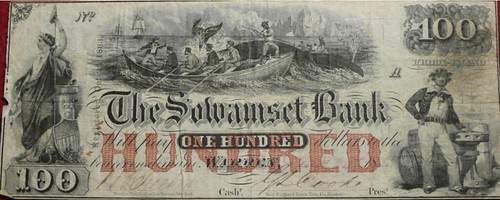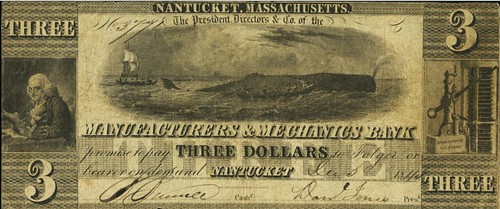
PREV ARTICLE
NEXT ARTICLE
FULL ISSUE
WHALING INDUSTRY ON NEW ENGLAND NOTESJohn Ferreri published an article on whaling vignettes on New England state banknotes in the September 2022 issue of NENA News from the New England Numismatic Association. With permission, we're publishing an excerpt here. Thank you, -Editor
This is an unusual vignette appearing on the above note and enlarged vignette, below. There are no reports of it being used on notes of any other bank. One can easily see the potential danger whalers had when trying to harpoon an animal as large as a Right Whale. A whaleboat was designed to be very narrow and usually had six crew members, five to row and one to steer. The foremost rower doubled as the lancer. This image is notable in that we can see the diversity of the crew. People came from many countries to New England to work in the whaling trade. Also notable is the view of the ice shelf in the background. Ice shelves are more numerous in the South Sea of the Pacific, and the whale ships would often spend a year or more hunting in that area. There were also whaling ports on the New England coast that exclusively outfitted their ships for long stays in the southern Pacific or South Sea. On Nantucket Island the Pacific Bank (appropriately named) catered to those ships and seamen who traveled to those far seas.
During the heady 19th century, many seaside villages grew into towns
and later cities, as commerce followed the population. Where there is
commerce and a growing population there will be a need for banking
services. Not surprisingly, many new banks were founded to service the
local communities. At this same time, the U.S. government had not yet
begun to issue paper money to compliment the coinage issues. As such,
these banks were given permission by their home states to issue paper
money if they wished. Some of these banks placed vignettes of whaling
scenes on their banknotes so to demonstrate their connection with the
industry now so prevalent in these areas. Various images of seaports, the
seacoast, shipbuilding, whaling, as well as fishing started to be seen in
the vignettes on many of the colorful banknote issues from banks in these
seaside towns. A truly multi-ethnic industry, whaling ships employed
people from Portugal, the Azores, and Cape Verde, Blacks from New
England and the Caribbean, as well as Native Americans to name a few.
This is evident on many of the highly detailed images on these banknotes.
The whales most coveted in New England and Canadian waters were the
Right Whales, so named because they were the One of the largest whales is the Sperm Whale. Although not particularly plentiful this animal may be found in oceans throughout the world and in somewhat abundant numbers off the island of Nantucket. This is the type of whale that the story, Moby Dick was about. Moby Dick was a white Sperm Whale! The Sperm Whale was so called because of the resemblance of the oil in its head to seminal fluid. The vignette of this note will show a whaleboat approaching very close to the side of the surfaced Sperm Whale while the crew member with the harpoon or lance is about to drive his weapon into the beast! The Nantucket Whale hunters developed a specialty for hunting Sperm Whales as is illustrated on this banknote!
Image, courtesy of Heritage Auctions
For more information on the New England Numismatic Association, see:
Wayne Homren, Editor The Numismatic Bibliomania Society is a non-profit organization promoting numismatic literature. See our web site at coinbooks.org. To submit items for publication in The E-Sylum, write to the Editor at this address: whomren@gmail.com To subscribe go to: https://my.binhost.com/lists/listinfo/esylum All Rights Reserved. NBS Home Page Contact the NBS webmaster 
|



